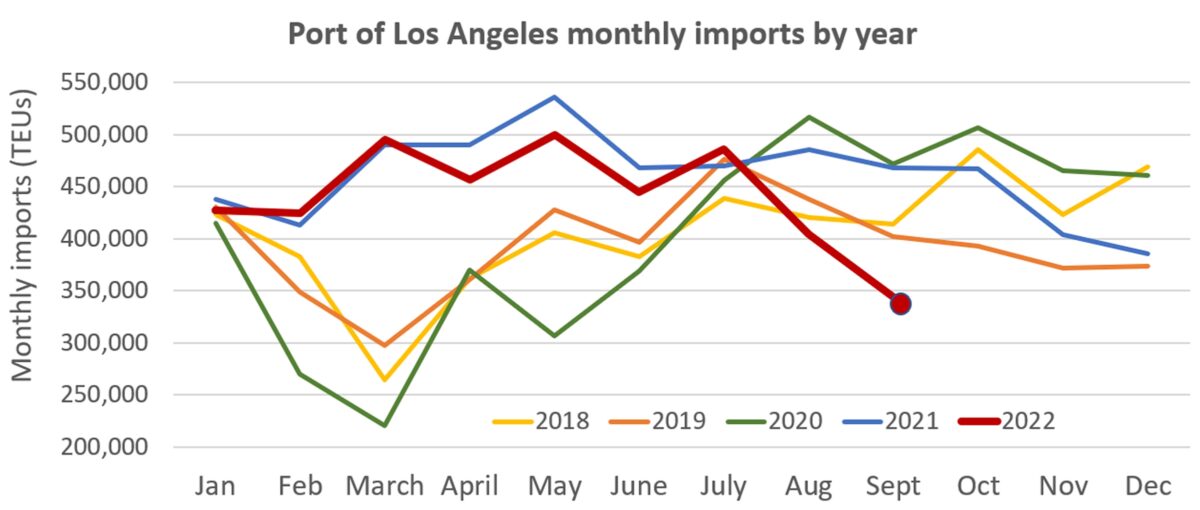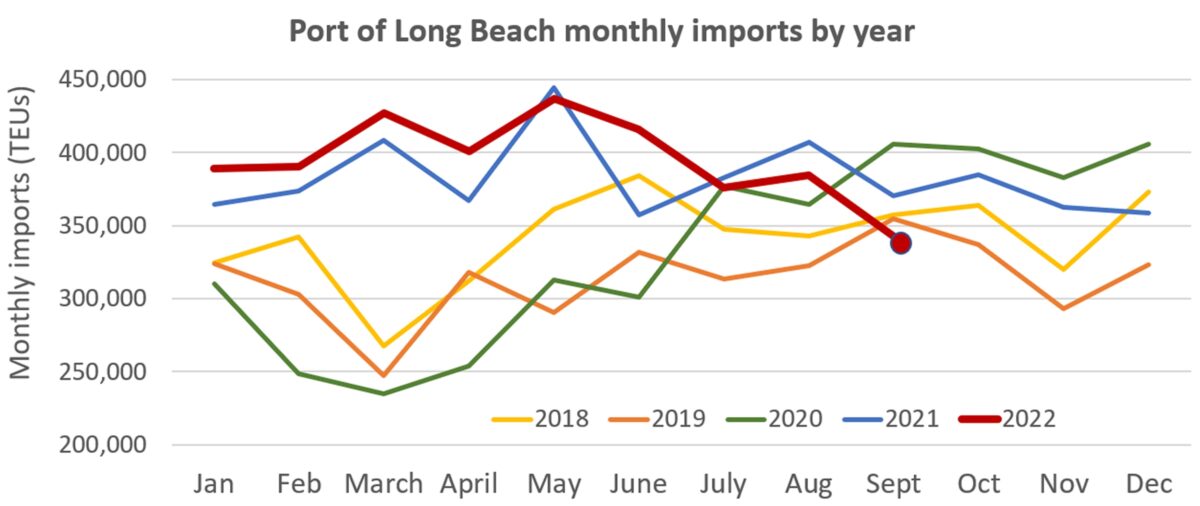September is usually a strong month for West Coast imports as U.S. companies bring in their year-end holiday goods. Not so in 2022.
On Wednesday, the Port of Los Angeles reported its lowest import total for September since 2009, amid the Great Recession. The day before, the neighboring Port of Long Beach posted its weakest import total for September since 2016.
Imports to Southern California ports are falling fast because shippers have shifted volumes to East and Gulf coast ports, fearing disruptions from West Coast port labor negotiations. Simultaneously, volumes are now pulling back nationwide due to falling demand.
Holiday imports ‘dropped precipitously’
“In the month of September is where the real story lies,” explained Gene Seroka, executive director of the Port of Los Angeles, during a news conference on Wednesday.
Earlier this year, imports of durable goods bought heavily during the pandemic — furniture, appliances, etc. — began pulling back. In September, declines were heavily driven by reductions in holiday goods, as well.
“September is traditionally a high-volume month for end-of-year products,” said Seroka. “Think toys and games, clothing, footwear and other products. Those holiday gift items dropped precipitously compared to last September, mainly because they came in earlier. This year our peak season was in June and July, as savvy importers moved up the arrival of these goods to bring some certainty back to when they could get to market.”
Commenting on the shift to East and Gulf coast ports, Seroka said “concern over the dockworkers labor contract negotiations [was] a major factor contributing to volume declines.” He believes the shift “is likely to continue until a West Coast labor contract is in place — and that can’t happen soon enough.” The previous contract expired July 1.
Asked by American Shipper how October’s volumes are shaping up versus September’s, he said they will be “probably about the same or a little bit lighter. It’s going to be a soft October.”
LA September imports down 15% vs. August
The Port of Los Angeles reported total throughput of 709,873 twenty-foot equivalent units in September, down 21.5% year on year (y/y). Exports came in at 77,680 TEUS, up 2.6% y/y, while empties totaled 288,731 TEUs, down 19.8% y/y.
Loaded imports to Los Angeles totaled just 343,462 TEUs, down 26.6% y/y. Imports fell 15.1% sequentially versus August, following a 16.7% drop in August versus July.
Los Angeles’ imports reached their highest level this year in May. September imports were down 31.3% compared to that month. Imports in September were the lowest for any month since May 2020, when the U.S. was in the midst of COVID-19 lockdowns.

Long Beach September imports down 11% vs. August
The Port of Long Beach reported total throughput of 741,823 TEUs for September, down 0.9% y/y. Exports came in at 112,940 TEUs, up 1.9% y/y, and empties totaled 286,212 TEUs, up 7% y/y.
Long Beach handled 342,671 TEUs of imports in September, down 7.4% y/y and down 10.9% sequentially versus August. As in Los Angeles, Long Beach’s imports peaked this year in May. September was down 27.5% from that high. Monthly imports have not been this low since June 2020.

Port of Long Beach Executive Director Mario Cordero blamed the import decline on consumer and retail concerns about inflation, “leading to warehouses filled with inventory and fewer product orders from Asia.”
Fewer ships being worked at berths
The focus during the supply chain crisis was on the massive number of container ships at anchorages or loitering offshore as they waited for berths in Los Angeles or Long Beach. Statistics from the Marine Exchange of Southern California show a steep drop throughout this year, from a high of 109 waiting container ships Jan. 9 to just four on Wednesday, the lowest number since October 2020.
The Marine Exchange also collects data on the number of container ships at the berths in the two ports. This data also shows a major — and more recent — change.
As the supply crisis intensified, there were often over 30 ships at the two ports’ berths each day. Between August 2021 and February 2022, there were an average of 28.8 container vessels alongside in Los Angeles and Long Beach daily.
In recent weeks, however, the numbers have sunk to much lower levels. The average from Sept. 1 through Tuesday was 19 ships alongside, down over 30% from peak levels. There were 18 ships at the ports’ berths Tuesday. There were only 10 ships alongside on Sept. 12.
This is getting closer to pre-COVID levels. The average number of ships at the ports’ berths daily in full-year 2019 was 14.8.

Click for more articles by Greg Miller
Related articles:
- Container-ship logjams off US ports finally easing as imports fall
- US imports sink in September, suffer steepest drop since 2020 lockdowns
- Tidal wave of new container ships: 2023-24 deliveries to break record
- If supply chain crunch is finally easing, why is inflation so high?
- Container shipping lines suddenly a lot less interested in renting ships
- Fall in container spot rates ‘much steeper,’ ‘less orderly’ than expected
- West Coast ports sink to lowest share of US imports since early 1980s







